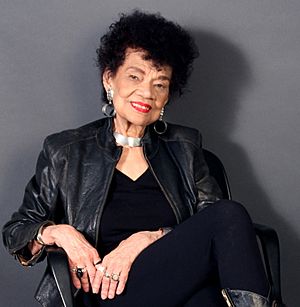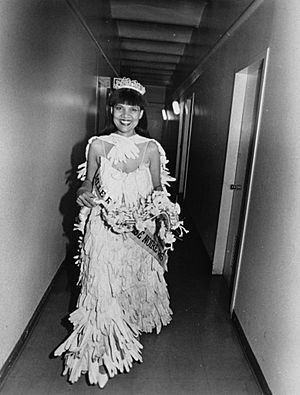Lorraine O'Grady facts for kids
Quick facts for kids
Lorraine O'Grady
|
|
|---|---|

Lorraine O'Grady in 2014
|
|
| Born | September 21, 1934 |
| Died | December 13, 2024 (aged 90) |
| Known for | Criticism, Conceptual Art, Performance Art |
Lorraine O'Grady (September 21, 1934 – December 13, 2024) was an American artist, writer, and critic. She created conceptual art and performance art. Her work often included photos and videos. She explored what it means to be a Black woman. She looked at how identity is shaped by moving to new places and mixing cultures. O'Grady studied at Wellesley College and the University of Iowa Writers' Workshop. She became an artist when she was 45 years old. She believed art helps us remember we are all human.
Life and Early Work
Lorraine O'Grady was born in Boston, Massachusetts. Her parents, Edwin and Lena O'Grady, were from Jamaica. They helped start the first West Indian Episcopal church in Boston. O'Grady was drawn to the beauty of church rituals. She said these experiences shaped her artistic style.
In 1955, O'Grady graduated from Wellesley College. She studied economics and Spanish literature. Wellesley College honored her in 2017. She later studied fiction writing at the Iowa Writers' Workshop. Before becoming a full-time artist in 1980, she had many jobs. She worked as an intelligence analyst for the government. She was also a professional translator and a rock music critic. O'Grady lived and worked in New York City.
Lorraine O'Grady passed away at her home in New York on December 13, 2024.
Artistic Practice and Career
In the early 1980s, O'Grady created a special character. She called this character Mlle Bourgeoise Noire. This character would show up at art openings. She wore a dress and cape made of 180 white gloves. At first, she gave out flowers. Then, she would hit herself with a white studded whip. She called it "the whip-that-made-the-plantations-move." While doing this, she would shout protest poems. These poems spoke out against the segregated art world. She felt it left out Black artists. Her first performance as Mlle Bourgeoise Noire was in 1980. It took place at Linda Goode Bryant's Just Above Midtown gallery.
Mlle Bourgeoise Noire also helped organize art shows. One was called The Black and White Show in 1983. It was at Kenkeleba House, a gallery run by Black artists. The idea was to show art by 30 Black artists and 30 white artists together. In 1991, O'Grady began adding photo installations to her art.
In 1983, O'Grady created a final performance for Mlle Bourgeoise Noire. It was called Art Is.... This performance was a parade float. It was part of the annual African American Day Parade in Harlem. The float had a large, empty gold picture frame. O'Grady and 15 performers walked with the float. They carried smaller gold frames. They held these frames up to people in the crowd. This encouraged onlookers to see themselves as art. It also highlighted racism in the art world. O'Grady's photos from this performance celebrate Black culture. They also show that avant-garde art can be a Black art form.
From 2015 to 2016, Art Is... was shown at the Studio Museum in Harlem. An assistant curator there said O'Grady's performance helped Harlem residents see themselves as art. In 2020, some of O'Grady's Art Is... photos were in an exhibit. It was called Visibilities: Intrepid Women of Artpace. People at the Crystal Bridges Museum of American Art said the event was powerful. They heard people shout, "That's right. That's what art is. We're the art!"
In 2020, Lorraine O'Grady worked on a new performance. It was called Announcement of New Persona (Performances to Come!). For this, O'Grady wore a custom-made suit of armor. She posed with a sword and helmet. The helmet sometimes had palm trees growing from it. This performance debuted at the Brooklyn Museum.
In September 2022, The New Yorker Magazine wrote about O'Grady. She was 88 years old at the time.
Exhibitions
O'Grady first showed her art when she was 45. Before that, she had many successful jobs. Her art often focused on feminist ideas. It has been shown widely in New York City and Europe. Her early Mlle Bourgeoise Noire performance gained new attention. It was a key part of the exhibit WACK! Art and the Feminist Revolution. This was a major museum show about the feminist art movement.
Interest in O'Grady's work has grown steadily. In 2009, she had a solo exhibit. It was at Art Basel Miami Beach, a very important contemporary art fair. She was also chosen for the 2010 Whitney Biennial. Her art has been in many important shows since then. These include Radical Presence: Black Performance in Contemporary Art.
She was also featured in "We Wanted a Revolution: Black Radical Women 1965–85." This exhibit explored Black feminist art. It showed how artists used different ways to express their ideas. These included video, sculpture, performance, and photography. The exhibit placed each artist's work in its historical time.
A large show of her work, Lorraine O'Grady: Both/And, was at the Brooklyn Museum. It ran from March to July 2021. For this show, she worked with art historian Aruna D'Souza. They created a book of O'Grady's writings. After the Brooklyn Museum, Both/And was shown at the Davis Museum at Wellesley College. This was O'Grady's old college.
Writings
O'Grady's collected writings were published in 2020. Aruna D'Souza helped edit them. She wrote articles for Artforum magazine and Art Lies. Her essay, "Olympia's Maid: Reclaiming Black Female Subjectivity," has been published many times. It explores what it means for Black women to define themselves. D'Souza said O'Grady's words are "a gift, a call to action, and a vision of a world as it could be."
Awards
From 1995 to 1996, O'Grady was a Bunting Fellow at Harvard University. There, she learned a lot about the early internet.
In 1997–98, she was a Senior Fellow at the Vera List Center for Art and Politics. In 2009, she received the Anonymous Was A Woman award. She also received a Rockefeller Fellowship in Visual Art in 2011. In 2014, she got the College Art Association's Distinguished Feminist Award. She received a Creative Capital Award in Visual Art in 2015.
In October 2017, she received the Alumnae Achievement Award. This is the highest honor given to graduates of Wellesley College.
In 2024, O'Grady was given a Guggenheim Fellowship in Fine Arts.
Collections
O'Grady's art is part of the permanent collections of many museums. These include:
- Museum of Modern Art, New York
- Art Institute of Chicago, Illinois
- Brooklyn Museum, New York
- Davis Museum and Cultural Center, Wellesley, Massachusetts
- Fogg Museum at Harvard, Cambridge, Massachusetts
- Los Angeles County Museum of Art, California
- Rose Art Museum, Brandeis University, Waltham, Massachusetts
- Studio Museum in Harlem, New York
- Wadsworth Atheneum, Hartford, Connecticut
- Walker Art Center, Minneapolis, Minnesota
- Worcester Art Museum, Massachusetts
- Pérez Art Museum Miami


